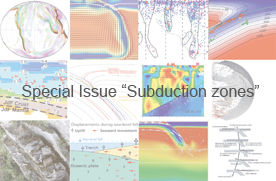Effect of glacial-interglacial sea-level changes on the displacement and stress field in the forearc and along the plate interface of subduction zones
Abstract. Combined seismological, space-geodetic and numerical studies have shown that the seismicity at subduction zones may be modulated by tides and glacier fluctuations on timescales of 1–100 a, because these changes in loads on Earth's surface are able to alter the stress field in the upper plate and along the plate interface. Here we use a two-dimensional finite-element model of a subduction zone to investigate how glacial-interglacial sea-level changes affect the forearc region and the plate interface. The model results show that a sea-level fall by 125 m over 100 ka causes up to 0.7 m of vertical displacement, with the maximum uplift occurring between the trench and the coast. The uplift signal induced by the sea-level fall decreases to zero ~20 km landward of the coastline. A subsequent sea-level rise by 125 m over 20 ka causes subsidence, which is again most pronounced in the submarine part of the forearc. The sea-level changes cause horizontal displacements of up to 0.12 m, which are directed seaward during sea-level fall and landward during sea-level rise. With respect to the stress field, the sea-level changes lead to variations in the vertical stress and the shear stress of up to 1.23 MPa and 0.4 MPa, respectively. The shear stress variations are highest beneath the coast, i.e. in the area where the sea-level changes cause the strongest flexure. The resulting Coulomb stress changes on the plate interface are of the order of 0.2–0.5 MPa and indicate that earthquakes are promoted during sea-level fall and delayed during sea-level rise. Our findings imply that eustatic sea-level changes during glacial-interglacial periods may have induced displacements and stress changes that were large enough to affect the seismic cycle of subduction thrusts.






